Rotation and Power of Pulsars and the Accretion Disks
How a Cosmic Lighthouse Works
A Pulsar is basically a neutron star that has been spun up to very high rotation rates by one of several means (which we will discuss below). These rates are almost beyond comprehension. If our Sun were shrunk to the size of a neutron star—about 10 km in radius, conservation of angular momentum would mean it would have to rotate about 1000 times a second.
That’s what pulsars do.
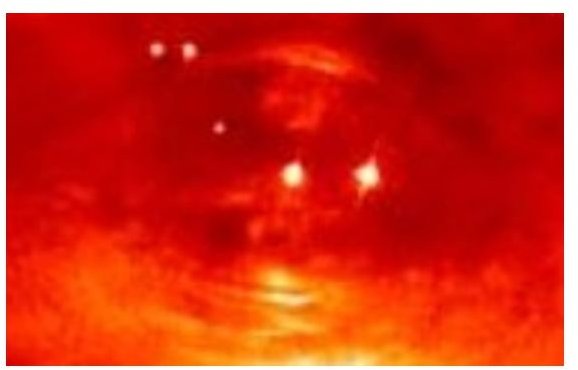
There’s another conservation law that comes into effect when a star collapses to a neutron star—the conservation of magnetic flux. Again, if our Sun were shrunk to neutron star size, its magnetic field, which is about 12,000 Gauss, would increase to 1012 Gauss. That generates another phenomenon.
This intense magnetic field, combined with the rapid rotation generates strong electric fields. Move a magnetic field over a conducting surface and you create an electric current. This ‘current’ consists of electrons that are accelerated towards the magnetic poles where the magnetic flux is strongest. In any situation, if you accelerate charged particles, you generate electromagnetic radiation—thus radio frequencies are generated.
As the pulsar’s magnetic poles rotate around in the direction of Earth, it sends a burst of radiation in our direction. It is always ‘broadcasting’ this signal, but we pick it up only when it is pointed at us.
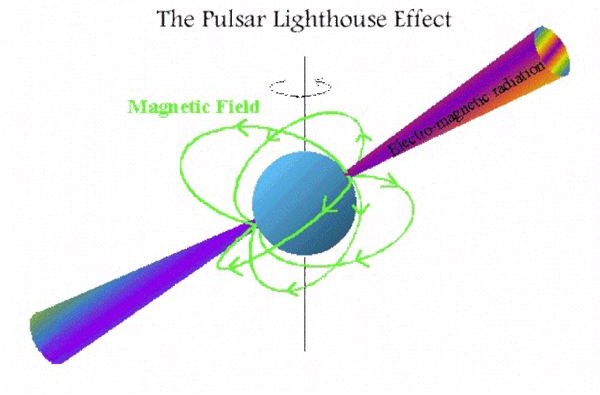
It is for this reason many astronomers believe all neutron stars are or once were pulsars. They just aren’t pointing our way.
Tick Tock
The signals from pulsars are unimaginably regular. Almost as regular as our atomic clocks. Most pulsars broadcast signals that are about a second apart, which means they are rotating once a second. But some are beeping at us every few milliseconds. Pulsar PSR J1603-7202 has a period of 0.0148419520154668 seconds. Some have periods as long as eight seconds.
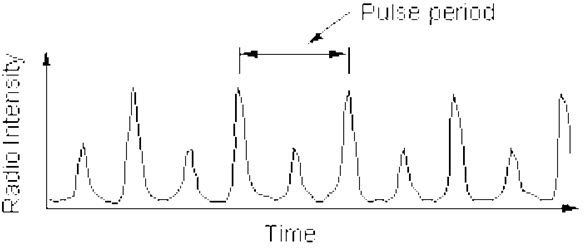
The very short period ones are known as millisecond pulsars. All others are called ordinary pulsars.
Why such a difference in time periods? Well. It seems that pulsars, like us humans, slow down with age. Some it appears slow rather quickly, in astronomical terms, existing as a pulsar for just a few thousand years. Their rotation then has slowed to a point that the charged particles are no longer being accelerated rapidly enough to generate radiation.
The millisecond pulsars, on the other hand, slow slowly - PSR J1603-7202 is slowing only 0.0000005 seconds every million years!
Spinning Them Up
So how do pulsars get spun up to such incredible rotation rates? It’s all in how they are formed. All neutron stars, pulsars included, are the result of the collapse of a star above 40 solar masses well along into its evolution. It collapses beyond the white dwarf stage, and begins to fuse oxygen and magnesium into iron. At this point, the electrons are forced into the protons in the nucleus of the atoms and the remaining material collapses to that 10 km core. The conservation of angular momentum we discussed causes the compact core to spin up like a top to those incredible rates.
There is another mechanism that puts spin on pulsars. Most stars in the galaxy are members of double star systems. Our Sun is one of the few exceptions. If one of the members of the system collapses to a neutron star, its tremendous gravitational pull will suck material from its companion and wrap it around itself in an accretion disk. As this material wraps around the collapsed star, it adds mass and speeds up the rotation.
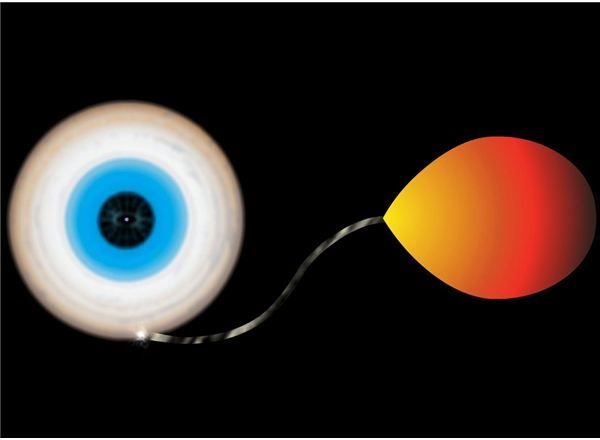
This is how the millisecond pulsars are created. The material from the companion star is accelerated to the poles of the pulsar by the intense magnetic field, and this accelerated plasma also generates electromagnetic energy. In this case it is X-rays and we have an X-ray pulsar.
Millisecond pulsars also generate gamma rays. The charged particles are being accelerated to such high velocities they produce this high energy radiation. Some rapidly rotating pulsars produce all four types of radiation—light, radio emissions, X-Rays and gamma rays.
As a pulsar’s rotation slows, the high energy gamma ray production ceases first.
In binary systems, eventually enough material is pulled away from the companion star that it undergoes volatile changes itself. Depending on its original size, it becomes a white dwarf, a black hole, or another millisecond pulsar.
Space Time Laboratory
In fact astronomers have found binary pulsars.
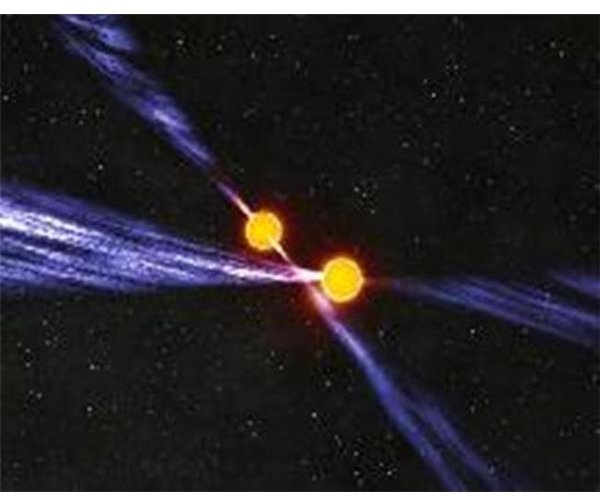
And they turn out to twist the fabric of space time into knots.
The two tiny companions orbit each other in a relativistic dance that is a cosmic lab for Einstein’s laws. When the two are closest to each other and their huge gravitational fields combine to be strongest, the stars travel faster and their pulses slow down. In other words, time slows down just as relativity predicts. When the two move further apart, they travel more slowly, and just as relativity says, their pulses speed up.
That’s not all that is happening in the relativistic piece of the cosmos binary pulsars create. As they orbit each other, their orbits shrink over time. The orbits of the first binary pair found are shrinking by about 3.1 mm per orbit. Some 300 million years from now they will bump into each other.
Will they merge, or destroy each other? Or will their extreme gravity and intense magnetic fields cause them to bounce off each other like billiard balls and go careening through the galaxy like banditos on the run from the law?
That apparently has happened. NASA has discovered several runaway neutron stars, presumably former binary pulsars, rushing through the galaxy at breakneck velocities. Some have escaped the galaxy and are headed into intergalactic space. One is headed in our direction at 240,000 mph.

It is not expected to come close enough to the Solar System to have any affect when it swings by 170 lys away 300,000 years from now.
What is the effect on the fabric of space time in their vicinity when these binary pulsars approach each other and dart off into the cosmos, some even leaving the galaxy?
It would certainly be a fascinating space time experiment to see.
Sources and Credits
Binary pulsars: Manchester University https://www.jb.man.ac.uk/research/pulsar/Education/Tutorial/tut/node84.html
Pulsars: University of Calfornia at San Diego https://casswww.ucsd.edu/public/tutorial/SN.html
Binary pulsars: Cornell University https://www.astro.cornell.edu/academics/courses/astro201/psr1913.htm
Pulsars: NASA https://imagine.gsfc.nasa.gov/docs/science/know_l2/pulsars.html
Pulsars: Australian Telescope Outreach annd Education https://outreach.atnf.csiro.au/education/everyone/pulsars/
Runaway star: NASA https://hubblesite.org/newscenter/archive/releases/2000/35/text/
CREDITS
pulsar:://apod.nasa.gov/apod/image/9809/crab_hst
Accretion disk: National Radio Astronomy Observatory (Canada) https://www.nrao.edu/pr/2009/mspulsarbirth/
All other photos and drawings: NASA and Hubble Site
.